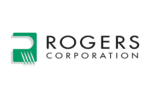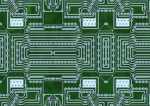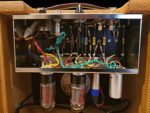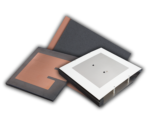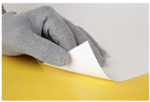Rogers Corporation is pleased to introduce SpeedWave 300P Ultra-Low Loss Prepreg. With the increasing need for stackup flexibility in high layer count designs for 5G mmWave, high resolution 77 GHz automotive radar, aerospace & defense and high speed digital designs, SpeedWave 300P prepreg offers a broad range of competitively priced high performance options for the […]
rogerscorporation
Glass-reinforced thermoset now available in multiple thicknesses
Wireless circuit designers can now enjoy a true breakthrough with Rogers Corporation’s RO4450T bondply. This product offers designers a spread glass reinforced bonding material in seven thickness options ranging between 0.0025” (0.064mm) and 0.006” (0.152mm), greatly improving flexibility for high multilayer board count designs. RO4450T glass reinforced thermoset bondplies were developed for wireless circuit designers […]
Printed Circuit Boards, Part 4: Beyond FR-4
Part 4 concludes this FAQ with some fabrication issues and at substrates with performance which is multi-GHz-compatible and goes beyond that available using FR-4 material. Q: What’s the set-up situation for PC board fabrication? A: The production-level fabrication process is optimized for runs of tens, hundreds, and thousands of boards, as there is a set-up […]
Printed Circuit Boards, Part 3: Vias and multilayer boards
Part 1 of this FAQ series looked at the ubiquitous FR-4 PC board as well as other PC board issues, and Part 2 reviewed highlighted some of the board issues and the widely used FR-4 PC board substrate. This third part looks at advanced PB board issues such as vias and multilayer boards. Q: How […]
Printed Circuit Boards, Part 1: Context and phenolic boards
Despite appearances, there’s nothing simple about the materials or fabrication of the ubiquitous PC board, and the requirements of multi-GHz systems are increasing the performance demands placed on these boards. We take the standard, usually green, printed circuit board (PC board or PCB) for granted, but it has an interesting history, alternatives, and future. This […]
Next-gen laminates improve insertion loss in automotive radar sensor applications
Rogers Corporation announced the latest addition to its RO3000 Series PTFE circuit materials: RO3003G2 high-frequency laminates. RO3003G2 laminates build on Rogers’ RO3003 platform to provide radar sensor designers with improved insertion loss and reduced dielectric constant (Dk) variation. The combination of our optimized resin and filler content along with the introduction of Very Low Profile ED […]
High-impedance laminates help reduce antenna size
Rogers Corporation has introduced MAGTREX 555 Laminates, the first product in a new platform of high-impedance laminates featuring a high permeability and permittivity. These high-impedance laminates enable antenna designers to expand the trade-space of their antenna design enabling up to a factor of six reductions in size with minimal impact on bandwidth, up to a factor of […]
New laminates target base station antenna apps
Rogers Corporation has introduced two new products: AD300D laminates and IM Series laminates. AD300D fourth generation, commercial microwave and RF laminate material extends the capabilities of the successful AD300 product grade. This ceramic-filled, glass-reinforced, PTFE based material provides the controlled dielectric constant (2.94±0.05), low loss performance (0.0021 at 10GHz), very good passive intermodulation response (-159dBc […]
Low-loss bondply material for high-frequency circuit boards
Rogers Corporation introduces the RO4460G2, a low-loss bondply with a 6.15 dielectric constant (Dk). RO4000® thermoset high performance bonding layers have long been used by circuit designers for multilayer board constructions using Rogers high frequency and high speed digital materials where operating frequency, dielectric constant, or high-speed signal requirements dictate the need for high performance […]


